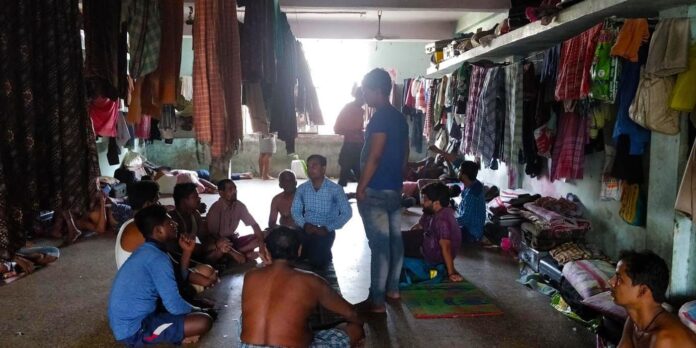Odia migrant workers in Surat’s booming textile industry face persistent caste-based segregation that mirrors the social hierarchies of their home state. While migration offers financial stability and better economic prospects, it has largely failed to dismantle entrenched caste identities that continue to shape their lives in the industrial city.
Caste and Migration: A Double-Edged Sword
The migration of Odia workers to Surat, primarily for employment in the textile industry, has been a significant economic lifeline. Many hail from rural areas of Odisha, where opportunities for stable income are limited. In Surat, these migrants earn better wages and gain access to improved living conditions. However, the deeply rooted caste dynamics of their villages accompany them to the city.

Caste remains a key factor in determining access to shared spaces, including accommodations and community dining arrangements. Dalit workers often face exclusion from messes and cooking roles, reinforcing caste-based segregation even in a new environment.
Living Arrangements: A Reflection of Caste Divides
Accommodation practices among Odia migrants in Surat reveal the persistence of caste boundaries. Workers typically form living groups based on caste affiliations, often segregating Dalits from upper-caste members. This separation extends to shared kitchens, where Dalit workers are sometimes prohibited from cooking or even eating alongside their upper-caste counterparts.
These practices mirror traditional rural hierarchies and indicate that migration, while offering economic upliftment, has limited impact on breaking caste barriers.
Economic Stability vs. Social Inequality
Migration provides Odia workers with steady incomes, allowing them to send remittances back home, fund education for their children, and build better futures. Yet, this financial stability coexists with social inequalities that continue to define their interactions and opportunities in Surat.
Dalit workers, in particular, face systemic disadvantages despite their economic contributions to the textile industry. They are often relegated to less desirable jobs within factories and excluded from leadership roles in worker committees or labor unions.
Historical Context of Caste in Odisha
The caste system in Odisha has historically played a significant role in structuring society. Rural Odisha remains deeply stratified, with Dalits often confined to low-income occupations and denied access to resources. These social dynamics are carried over when workers migrate, perpetuating the same divisions in urban industrial settings like Surat.
Social Networks and Community Dynamics
Odia migrant communities in Surat rely heavily on social networks for support, particularly when it comes to finding jobs and housing. These networks are often organized along caste lines, further entrenching segregation. Dalits frequently find themselves excluded from these networks, limiting their access to better job opportunities and social mobility.
For many, this exclusion fosters a sense of alienation, making it harder for Dalit workers to integrate fully into the migrant community.
Challenges in Breaking the Caste Barrier
Efforts to address caste-based inequalities among Odia migrants in Surat face significant hurdles.
- Lack of Awareness: Many migrants view caste segregation as a continuation of cultural traditions rather than a social injustice.
- Economic Dependence: Fear of losing economic opportunities prevents many from challenging caste-based practices.
- Limited Support Systems: Migrants often lack access to organizations or legal frameworks that could help them address caste discrimination.
Pathways to Change
Despite these challenges, there are opportunities to address caste dynamics among Odia migrant workers:
- Awareness Campaigns: Educating workers about their rights and the importance of social integration could help challenge caste-based practices.
- Community Initiatives: Establishing inclusive community centers and mess facilities could foster unity among workers from different castes.
- Union Advocacy: Labor unions can play a key role in promoting equality by ensuring that Dalit workers receive fair treatment and representation.
- Policy Interventions: Government regulations could address caste discrimination in industrial settings, creating a safer and more inclusive environment for all workers.
The Way Forward
The experience of Odia migrant workers in Surat highlights the complex interplay between economic mobility and social inequality. While migration offers significant financial benefits, it struggles to dismantle caste-based hierarchies that remain deeply ingrained in the social fabric.
Efforts to address these issues must focus on fostering inclusivity and breaking down barriers that divide workers along caste lines. By tackling these challenges, the Odia migrant community in Surat can move toward a future where economic stability is not undermined by social inequalities.

